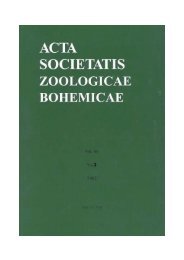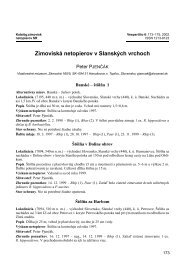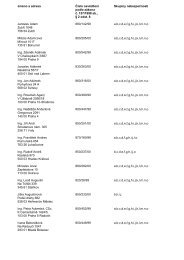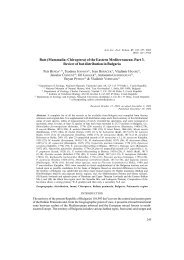Untitled
Untitled
Untitled
Create successful ePaper yourself
Turn your PDF publications into a flip-book with our unique Google optimized e-Paper software.
Ann M. Therriault – Richard A. F. Grieve – Mark Pilkington<br />
Figure 9. Photomicrograph of partial conversion to maskelynite of plagioclase<br />
feldspar crystals, Manicouagan, Canada, cross-polarized light,<br />
field-of-view = 5 mm.<br />
er than the crystalline form from which they are derived,<br />
but higher than thermally melted glasses of equivalent<br />
composition (e.g. Stöffler and Hornemann 1972, Langenhorst<br />
and Deutsch 1994). With increasing pressure, the<br />
bulk density of diaplectic glass decreases. This decrease is<br />
due in part to progressively greater portions of the mineral<br />
having been converted to low density, disordered phases,<br />
but also to the fact that diaplectic phases exist in a<br />
sequence of intermediate structural states, whose refractive<br />
index and density decrease with increasing pressure<br />
and temperature (Stöffler and Hornemann 1972). The refractive<br />
index of diaplectic glasses is also generally higher<br />
than for synthetic, or thermally melted, glasses of<br />
equivalent composition (e.g. Robertson 1973, Grieve et al.<br />
1996). However, in the case of K-feldspar, its diaplectic<br />
glass has a slightly lower refractive index than the fused<br />
feldspar glass (Stöffler and Hornemann 1972). Maskelynite,<br />
the diaplectic form of plagioclase (Fig. 9), is the<br />
most common example from terrestrial rocks; diaplectic<br />
glasses of quartz (Chao 1967) and of alkali feldspar<br />
(Bunch 1968) are also reported but in lesser abundance.<br />
Diaplectic glasses of different minerals can exist adjacent<br />
to one another without mixing (e.g. Robertson 1973).<br />
High-pressure polymorphs<br />
Shock can result in the formation of metastable polymorphs,<br />
such as stishovite and coesite from quartz (Chao<br />
et al. 1962, Langenhorst this volume) and diamond and<br />
lonsdaleite from graphite (Grieve and Masaitis 1996, Masaitis<br />
1998, Langenhorst this volume). Coesite and diamond<br />
are also products of endogenic terrestrial geological<br />
processes, including high-grade metamorphism, but the<br />
paragenesis and, more importantly, the geological setting<br />
are completely different from that in impact events.<br />
Under high pressure, the mineral lattice is unstable and<br />
is converted to a more stable configuration. Such transformation<br />
begins at ~ 11.5 GPa for K-feldspars (Robertson<br />
1973) and at ~ 12 GPa for quartz (De Carli and Milton<br />
1965). With increasing pressure, a greater proportion of<br />
the mineral is converted to a high-pressure polymorph until<br />
complete transformation is achieved at ~ 30 GPa for<br />
feldspars (Ahrens et al. 1969) and ~ 35 GPa for quartz<br />
(Stöffler and Langenhorst 1994). Neither the high-pressure<br />
phase of K-feldspar, thought to be the dense hollandite-type<br />
structure with Al and Si in octahedral<br />
co-ordination, nor an equivalent plagioclase polymorph<br />
have been recovered from shock experiments or identified<br />
in non-impact terrestrial rocks (Robertson 1973). It would<br />
appear that these phases are very unstable in postshock environments<br />
and, more likely, invert to more disordered,<br />
metastable phases. The high-pressure polymorphs of<br />
quartz (i.e. stishovite and coesite) have only rarely been<br />
produced by laboratory shock recovery experiments (cf.<br />
Stöffler and Langenhorst 1994). Contrary to what is expected<br />
from equilibrium phase diagram, stishovite is<br />
formed at lower pressures (12–30 GPa) than coesite<br />
(30–50 GPa; Stöffler and Langenhorst 1994) in impact<br />
events. This is mainly due to the fact that stishovite is<br />
formed during shock compression, whereas, coesite crystallizes<br />
during pressure release. In terrestrial impact structures,<br />
these polymorphs occur in small or trace amounts as<br />
very fine-grained aggregates and are formed by partial<br />
transformation of the host quartz. In crystalline or dense<br />
rocks, coesite is found in quartz with planar deformation<br />
features (PDFs) and strongly lowered refractive index and,<br />
more commonly, in diaplectic glass; whereas, in porous<br />
sandstone, coesite co-exists with > 80% of quartz displaying<br />
planar fractures (PFs) and diaplectic quartz glass<br />
(Grieve et al. 1996). Stishovite occurs most commonly in<br />
quartz with PDFs and less frequently in diaplectic glass<br />
(Stöffler 1971). For details on the characteristics of coesite<br />
and stishovite, the reader is referred to Stöffler and Langenhorst<br />
(1994) and references therein.<br />
Planar microstructures<br />
The most common documented shock-metamorphic<br />
effect is the occurrence of planar microstructures in tectosilicates,<br />
particularly quartz (Hörz 1968). The utility of<br />
planar microstructures in quartz reflects the ubiquitous nature<br />
of the mineral and its stability, including the stability<br />
of the microstructures themselves, in the terrestrial environment,<br />
and the relative ease with which they can be documented.<br />
For details, the reader is referred to the<br />
accompanying paper by Langenhorst. Recent reviews of<br />
the nature of the shock metamorphism of quartz, with an<br />
emphasis on the nature and origin or planar microstructures<br />
in experimental and natural impacts, can be found in<br />
Stöffler and Langenhorst (1994) and Grieve et al. (1996).<br />
Planar deformation features (PDFs) in minerals are<br />
produced under pressures of ~ 10 to ~ 35 GPa (Fig. 5).<br />
Planar fractures (PFs) form under shock pressures ranging<br />
from ~ 5 GPa up to ~ 35 GPa (Stöffler 1972, Stöffler and<br />
Langenhorst 1994).<br />
260








